Effect of Dispersed Reinforcement on Ultrasonic Pulse Velocity in Stabilized Soil
Abstract
:1. Introduction
2. Materials and Methods
2.1. Materials
2.1.1. Soil
2.1.2. Binder
2.1.3. Reinforcement
2.1.4. Mixtures
2.2. Methods
2.2.1. Sample Preparation Procedure and Care Process
2.2.2. Measurement Devices—Ultrasonic Pulse Velocity (UPV)
2.2.3. Measurement Devices—Unconfined Compressive Strength (UCS)
2.2.4. Non-Linear Relationship between Ultrasonic Pulse Velocity and Compressive Strength
2.2.5. Relationship between Ultrasonic Pulse Velocity and Elasticity Moduli
3. Results
3.1. Effect of Dispersive Reinforcement on Ultrasonic Pulse Velocity
- As the amount of binder in stabilized soils increases, the ultrasonic pulse velocity increases. This is due to the effect of the binder on the bonds produced between the particles of the manufactured matrix.
- A significant effect of fibers on the soil–cement matrix is a reduction in wave velocity. This is directly related to the increased number of interfaces in the wave propagation path [51]. In the obtained results, decreases in wave speed are noticeable, regardless of the amount of binder used. It is important to note that stronger connections are formed between the particles as the mixture is cured, which translates directly into reduced wave velocity reductions. Ultrasonic pulse velocity for mixtures with 5% binder content. It decreased to 81.43% after 7 days of curing and only to 89.02% after 28 days of curing.
- The use of dispersed reinforcement in stabilized soils also affects the received waves. A decrease in amplitude can be observed in samples with polypropylene fibers.
3.2. Results of Analysis of the Relationship between UPV and UCS
- Soil-binder matrix, without polypropylene fibers,
- Soil-binder-fiber matrix, polypropylene fibers in the amount of 0.25%,
- Soil-binder-fiber matrix, polypropylene fibers in an amount of 0.50%.
3.3. Results of Analysis of the Relationship between UPV and Elasticity Moduli
- 2439 [m/s] for —secant modulus;
- 2498 [m/s] for —secant moduli determined for half ultimate unconfined compressive strength.
- 2194 [m/s] for —secant modulus;
- 2291 [m/s] for —secant moduli determined for half ultimate unconfined compressive strength.
4. Discussion and Conclusions
- The use of dispersed reinforcement in the soil–cement matrix leads to a decrease in the velocity of the passing waves. In addition, lower values of the amplitudes of the received waves were noted. This suggests that the application of dispersed reinforcement also has an effect on wave attenuation.
- There is a limit to the reasonable use of dispersed reinforcement. Below this limit, increased compressive strength and higher elastic moduli of the matrix can be achieved. Beyond the limit of applicability of the reinforcement, the effect of increased compressive strength will be less noticeable. In addition, a reduction in elastic modulus values may occur. This aspect can be very important from a practical point of view. Knowing the limiting wave velocities in the tested material will allow a simple estimation of whether and to what extent we have increased not only the unconfined compressive strength but also the values of moduli of elasticity. Using the optimum amount of fiber will allow a lower amount of cement to be used.
- The type of curing used affects the results obtained. This is well illustrated by increasing the ultrasonic pulse velocity after the 21st day of mix curing. Knowing the effect of the type of curing on the soil stabilized with dispersed reinforcement may lead to misdiagnosis of the tested material. Currently, there are several types of applied treatment in stabilized soils. They differ in the time period spent in the water tank and the length itself. Further research would need to investigate the effect of different times of immersion of samples in water on the wave velocities obtained. This approach would allow correlating the ultrasonic pulse velocity with the moisture content of the mixtures. This may enable the application of the presented measurement method in the field.
- Effect of reinforcement type and length on ultrasonic pulse results. There are many types of dispersed reinforcement. To understand the impact of other materials, such as reinforcement made with recycled materials, this material reuse can significantly impact environmental protection.
- Influence of the basic materials that make up the matrix. The impact of different binders, soils, or the influence of moisture alone must be examined.
- Conduct field tests to verify the experiments performed. The key question is whether this method of improving mechanical properties can be used under field conditions. If so, will the improvement effect be similar to laboratory effects.
Author Contributions
Funding
Institutional Review Board Statement
Informed Consent Statement
Data Availability Statement
Conflicts of Interest
References
- McDowell, C. Stabilization of Soils with Lime, Lime-Flyash, and Other Lime Reactive Materials. Highw. Res. Board Bull. 1959, 231, 60–66. [Google Scholar]
- Firoozi, A.A.; Guney Olgun, C.; Firoozi, A.A.; Baghini, M.S. Fundamentals of Soil Stabilization. Int. J. Geo-Eng. 2017, 8, 26. [Google Scholar] [CrossRef] [Green Version]
- Petry, T.M.; Little, D.N. Review of Stabilization of Clays and Expansive Soils in Pavements and Lightly Loaded Structures—History, Practice, and Future. J. Mater. Civ. Eng. 2002, 14, 447–460. [Google Scholar] [CrossRef]
- Askarani, K.K.; Pakbaz, M.S. Drained Shear Strength of Over-Consolidated Compacted Soil-Cement. J. Mater. Civ. Eng. 2016, 28, 04015207. [Google Scholar] [CrossRef]
- Ayeldeen, M.; Hara, Y.; Kitazume, M.; Negm, A. Unconfined Compressive Strength of Compacted Disturbed Cement-Stabilized Soft Clay. Int. J. Geosynth. Ground Eng. 2016, 2, 28. [Google Scholar] [CrossRef] [Green Version]
- Consoli, N.C.; Foppa, D.; Festugato, L.; Heineck, K.S. Key Parameters for Strength Control of Artificially Cemented Soils. J. Geotech. Geoenviron. Eng. 2007, 133, 197–205. [Google Scholar] [CrossRef]
- Tran, K.Q.; Satomi, T.; Takahashi, H. Improvement of Mechanical Behavior of Cemented Soil Reinforced with Waste Cornsilk Fibers. Constr. Build. Mater. 2018, 178, 204–210. [Google Scholar] [CrossRef]
- Cristelo, N.; Glendinning, S.; Fernandes, L.; Pinto, A.T. Effects of Alkaline-Activated Fly Ash and Portland Cement on Soft Soil Stabilisation. Acta Geotech. 2013, 8, 395–405. [Google Scholar] [CrossRef]
- Cristelo, N.; Glendinning, S.; Miranda, T.; Oliveira, D.; Silva, R. Soil Stabilisation Using Alkaline Activation of Fly Ash for Self Compacting Rammed Earth Construction. Constr. Build. Mater. 2012, 36, 727–735. [Google Scholar] [CrossRef] [Green Version]
- Sousa, V.; Bogas, J.A. Comparison of Energy Consumption and Carbon Emissions from Clinker and Recycled Cement Production. J. Clean. Prod. 2021, 306, 127277. [Google Scholar] [CrossRef]
- Andrew, R.M. Global CO2 Emissions from Cement Production, 1928–2018. Earth Syst. Sci. Data 2019, 11, 1675–1710. [Google Scholar] [CrossRef] [Green Version]
- Favier, A.; De Wolf, C.; Scrivener, K.; Habert, G. A Sustainable Future for the European Cement and Concrete Industry: Technology Assessment for Full Decarbonisation of the Industry by 2050; ETH: Zurich, Switzerland, 2018; p. 96. [Google Scholar]
- de Juan, M.S.; Gutiérrez, P.A. Study on the Influence of Attached Mortar Content on the Properties of Recycled Concrete Aggregate. Constr. Build. Mater. 2009, 23, 872–877. [Google Scholar] [CrossRef]
- Gabryś, K.; Soból, E.; Sas, W. Physical, Deformation, and Stiffness Properties of Recycled Concrete Aggregate. Sustainability 2021, 13, 4245. [Google Scholar] [CrossRef]
- Giwangkara, G.G.; Mohamed, A.; Khalid, N.H.A.; Nor, H.M.; Hainin, M.R.; Jaya, R.P.; Sani, W.N.H.M.; Ismail, C.R.; Aziz, M.M.A. Recycled Concrete Aggregate as a Road Base Material. IOP Conf. Ser. Mater. Sci. Eng. 2019, 527, 012061. [Google Scholar] [CrossRef]
- Sas, W.; Głuchowski, A.; Soból, E.; Kulkowska, M. Experimental studies on crushing of recycled concrete aggregates. Acta Sci. Polonorum. Archit. 2015, 14, 13. [Google Scholar]
- Maduabuchukwu Nwakaire, C.; Poh Yap, S.; Chuen Onn, C.; Wah Yuen, C.; Adebayo Ibrahim, H. Utilisation of Recycled Concrete Aggregates for Sustainable Highway Pavement Applications; a Review. Constr. Build. Mater. 2020, 235, 117444. [Google Scholar] [CrossRef]
- Sas, W. Application of Recycled Concrete Aggregate in Road Engineering. Acta Sci. Polonorum. Archit. 2015, 14, 11. [Google Scholar]
- Vidal, H. The Principle of Reinforced Earth. Highw. Res. Rec. 1969, 282, 1–16. [Google Scholar]
- Akbulut, S.; Arasan, S.; Kalkan, E. Modification of Clayey Soils Using Scrap Tire Rubber and Synthetic Fibers. Appl. Clay Sci. 2007, 38, 23–32. [Google Scholar] [CrossRef]
- Berrabah, F.; Benmebarek, S.; Benmebarek, N. Three-Dimensional Numerical Analysis of Geosynthetic-Reinforced Embankment over Locally Weak Zone. Transp. Infrastruct. Geotech. 2020, 7, 269–296. [Google Scholar] [CrossRef]
- Rowe, R.K.; Liu, K.-W. Three-Dimensional Finite Element Modelling of a Full-Scale Geosynthetic-Reinforced, Pile-Supported Embankment. Can. Geotech. J. 2015, 52, 2041–2054. [Google Scholar] [CrossRef]
- Rowe, R.K.; Li, A.L. Geosynthetic-Reinforced Embankments over Soft Foundations. Geosynth. Int. 2005, 12, 50–85. [Google Scholar] [CrossRef]
- Brózda, K.; Selejdak, J. The Functions of the Geosynthetics in Roadway Applications. Acta Sci. Polonorum. Archit. 2019, 18, 27–31. [Google Scholar] [CrossRef]
- Consoli, N.C.; Vendruscolo, M.A.; Prietto, P.D.M. Behavior of Plate Load Tests on Soil Layers Improved with Cement and Fiber. J. Geotech. Geoenviron. Eng. 2003, 129, 96–101. [Google Scholar] [CrossRef]
- Consoli, N.C.; Vendruscolo, M.A.; Fonini, A.; Rosa, F.D. Fiber Reinforcement Effects on Sand Considering a Wide Cementation Range. Geotext. Geomembr. 2009, 27, 196–203. [Google Scholar] [CrossRef]
- Festugato, L.; Menger, E.; Benezra, F.; Kipper, E.A.; Consoli, N.C. Fibre-Reinforced Cemented Soils Compressive and Tensile Strength Assessment as a Function of Filament Length. Geotext. Geomembr. 2017, 45, 77–82. [Google Scholar] [CrossRef]
- Dwivedi, S.K.; Vishwakarma, M.; Soni, A. Advances and Researches on Non Destructive Testing: A Review. Mater. Today Proc. 2018, 5, 3690–3698. [Google Scholar] [CrossRef]
- Lukiantchuki, J.A.; de Oliveira, J.R.M.D.S.; de Almeida, M.D.S.S.; dos Reis, J.H.C.; Silva, T.B.; Guideli, L.C. Geotechnical Behavior of Construction Waste (CW) as a Partial Replacement of a Lateritic Soil in Fiber-Reinforced Cement Mixtures. Geotech. Geol. Eng. 2021, 39, 919–942. [Google Scholar] [CrossRef]
- Tang, C.; Shi, B.; Gao, W.; Chen, F.; Cai, Y. Strength and Mechanical Behavior of Short Polypropylene Fiber Reinforced and Cement Stabilized Clayey Soil. Geotext. Geomembr. 2007, 25, 194–202. [Google Scholar] [CrossRef]
- Ayeldeen, M.; Kitazume, M. Using Fiber and Liquid Polymer to Improve the Behaviour of Cement-Stabilized Soft Clay. Geotext. Geomembr. 2017, 45, 592–602. [Google Scholar] [CrossRef]
- Chen, M.; Shen, S.-L.; Arulrajah, A.; Wu, H.-N.; Hou, D.-W.; Xu, Y.-S. Laboratory Evaluation on the Effectiveness of Polypropylene Fibers on the Strength of Fiber-Reinforced and Cement-Stabilized Shanghai Soft Clay. Geotext. Geomembr. 2015, 43, 515–523. [Google Scholar] [CrossRef]
- Olgun, M. Effects of Polypropylene Fiber Inclusion on the Strength and Volume Change Characteristics of Cement-Fly Ash Stabilized Clay Soil. Geosynth. Int. 2013, 20, 263–275. [Google Scholar] [CrossRef]
- Miturski, M.; Głuchowski, A.; Sas, W. Influence of Dispersed Reinforcement on Mechanical Properties of Stabilized Soil. Materials 2021, 14, 5982. [Google Scholar] [CrossRef]
- Wang, W.; Zhang, C.; Guo, J.; Li, N.; Li, Y.; Zhou, H.; Liu, Y. Investigation on the Triaxial Mechanical Characteristics of Cement-Treated Subgrade Soil Admixed with Polypropylene Fiber. Appl. Sci. 2019, 9, 4557. [Google Scholar] [CrossRef] [Green Version]
- Hamidi, A.; Hooresfand, M. Effect of Fiber Reinforcement on Triaxial Shear Behavior of Cement Treated Sand. Geotext. Geomembr. 2013, 36, 1–9. [Google Scholar] [CrossRef]
- Consoli, N.C.; Prietto, P.D.M.; Ulbrich, L.A. Influence of Fiber and Cement Addition on Behavior of Sandy Soil. J. Geotech. Geoenviron. Eng. 1998, 124, 1211–1214. [Google Scholar] [CrossRef]
- Wang, B.; Zhong, S.; Lee, T.-L.; Fancey, K.S.; Mi, J. Non-Destructive Testing and Evaluation of Composite Materials/Structures: A State-of-the-Art Review. Adv. Mech. Eng. 2020, 12, 168781402091376. [Google Scholar] [CrossRef] [Green Version]
- Gupta, S. Comparison of Non-Destructive and Destructive Testing on Concrete: A Review. Trends Civ. Eng. Archit. 2018, 3, 351–357. [Google Scholar] [CrossRef] [Green Version]
- Malhotra, V.M. (Ed.) Handbook on Nondestructive Testing of Concrete, 2nd ed.; CRC Press: Boca Raton, FL, USA, 2004; ISBN 978-0-8493-1485-8. [Google Scholar]
- Mandal, T.; Tinjum, J.M.; Edil, T.B. Non-Destructive Testing of Cementitiously Stabilized Materials Using Ultrasonic Pulse Velocity Test. Transp. Geotech. 2016, 6, 97–107. [Google Scholar] [CrossRef]
- Yesiller, N.; Hanson, J.L.; Rener, A.T.; Usmen, M.A. Ultrasonic Testing for Evaluation of Stabilized Mixtures. Transp. Res. Rec. 2001, 1757, 32–42. [Google Scholar] [CrossRef]
- Ensminger, D.; Bond, L.J. Ultrasonics: Fundamentals, Technologies, and Applications, 3rd ed.; CRC Press: Boca Raton, FL, USA, 2011; ISBN 978-0-429-11948-4. [Google Scholar]
- Bortolotto, M.S. Bender Elements, Ultrasonic Pulse Velocity, and Local Gauges for the Analysis of Stiffness Degradation of an Artificially Cemented Soil. Master’s Thesis, Federal University of Rio Grande do Sul, Porto Alegre, Brazil, 2017; p. 273. [Google Scholar]
- Wei, X.; Liu, H.; Ku, T. Microscale Analysis to Characterize Effects of Water Content on the Strength of Cement-Stabilized Sand–Clay Mixtures. Acta Geotech. 2020, 15, 2905–2923. [Google Scholar] [CrossRef]
- Yesiller, N.; Hanson, J.L.; Usmen, M.A. Ultrasonic Assessment of Stabilized Soils. In Proceedings of the Soft Ground Technology, Noordwijkerhout, The Netherlands, 30 March 2001; pp. 170–181. [Google Scholar]
- Khan, Z.; Majid, A.; Cascante, G.; Hutchinson, D.J.; Pezeshkpour, P. Characterization of a Cemented Sand with the Pulse-Velocity Method. Can. Geotech. J. 2006, 43, 294–309. [Google Scholar] [CrossRef]
- Vinoth, G.; Moon, S.-W.; Moon, J.; Ku, T. Early Strength Development in Cement-Treated Sand Using Low-Carbon Rapid-Hardening Cements. Soils Found. 2018, 58, 1200–1211. [Google Scholar] [CrossRef]
- Panzera, T.H.; Christoforo, A.L.; de Paiva Cota, F.; Ribeiro Borges, P.H.; Bowen, C.R. Ultrasonic Pulse Velocity Evaluation of Cementitious Materials. In Advances in Composite Materials—Analysis of Natural and Man-Made Materials; Tesinova, P., Ed.; IntechOpen: London, UK, 2011; Available online: https://www.intechopen.com/chapters/18861 (accessed on 23 October 2021). [CrossRef] [Green Version]
- Chan, C.M.; Ch’ng, S.S. Preliminary Study of S-Wave Velocity and Unconfined Compressive Strength of Cement - Palf Stabilised Kaolin. Int. J. Integr. Eng. 2010, 2, 8. [Google Scholar]
- Cristelo, N. Influence of Discrete Fibre Reinforcement on the Uniaxial Compression Response and Seismic Wave Velocity of a Cement-Stabilised Sandy-Clay. Geotext. Geomembr. 2015, 43, 1–13. [Google Scholar] [CrossRef] [Green Version]
- Fatahi, B.; Fatahi, B.; Le, T.M.; Khabbaz, H. Small-Strain Properties of Soft Clay Treated with Fibre and Cement. Geosynth. Int. 2013, 20, 286–300. [Google Scholar] [CrossRef] [Green Version]
- PN-EN 1997-2:2007. Geotechnical Design—Part 2: Ground Investigation and Testing; PKN: Warszawa, Poland, 2009; Available online: https://sklep.pkn.pl/pn-en-1997-2-2009p.html (accessed on 23 October 2021).
- PN-EN ISO 14688-2:2018. Geotechnical Investigation and Testing—Identification and Classification of Soil; PKN: Warszawa, Poland, 2018; Available online: https://sklep.pkn.pl/pn-en-iso-14688-2-2018-05p.html (accessed on 23 October 2021).
- Napp, T.A.; Gambhir, A.; Hills, T.P.; Florin, N.; Fennell, P.S. A Review of the Technologies, Economics and Policy Instruments for Decarbonising Energy-Intensive Manufacturing Industries. Renew. Sustain. Energy Rev. 2014, 30, 616–640. [Google Scholar] [CrossRef]
- PN-EN 13286-50. Unbound and Hydraulically Bound Mixtures—Part 50: Method for the Manufacture of Test Specimens of Hydraulically Bound Mixtures Using Proctor Equipment or Vibrating Table Compaction; PKN: Warszawa, Poland, 2007; Available online: https://sklep.pkn.pl/pn-en-13286-50-2007p.html (accessed on 23 October 2021).
- PN-EN 14227-15:2015. Hydraulically Bound Mixtures—Specifications—Part 15: Hydraulically Stabilized Soils; PKN: Warszawa, Poland, 2015; Available online: https://sklep.pkn.pl/pn-en-14227-15-2015-12e.html (accessed on 23 October 2021).
- PN-EN 12504-4:2005. Testing Concrete—Part 4: Determination of Ultrasonic Pulse Velocity; PKN: Warszawa, Poland, 2005; Available online: https://sklep.pkn.pl/pn-en-12504-4-2005p.html (accessed on 23 October 2021).
- PN-EN ISO 16810:2014. Non-Destructive Testing—Ultrasonic Testing—General Principles; PKN: Warszawa, Poland, 2014; Available online: https://sklep.pkn.pl/pn-en-iso-16810-2014-06e.html (accessed on 23 October 2021).
- Tang, C.-S.; Wang, D.-Y.; Cui, Y.-J.; Shi, B.; Li, J. Tensile Strength of Fiber-Reinforced Soil. J. Mater. Civ. Eng. 2016, 28, 4016031. [Google Scholar] [CrossRef]
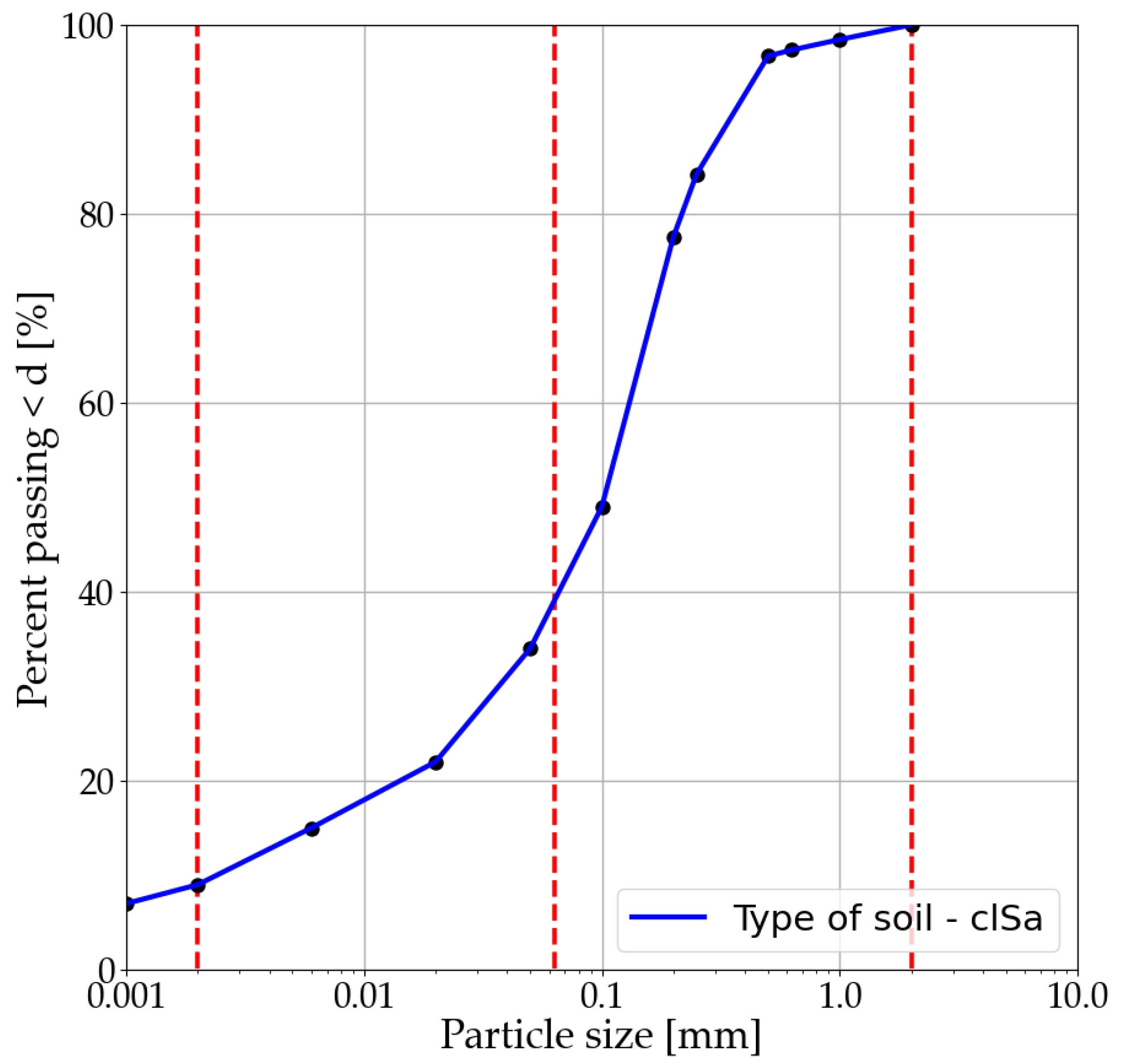
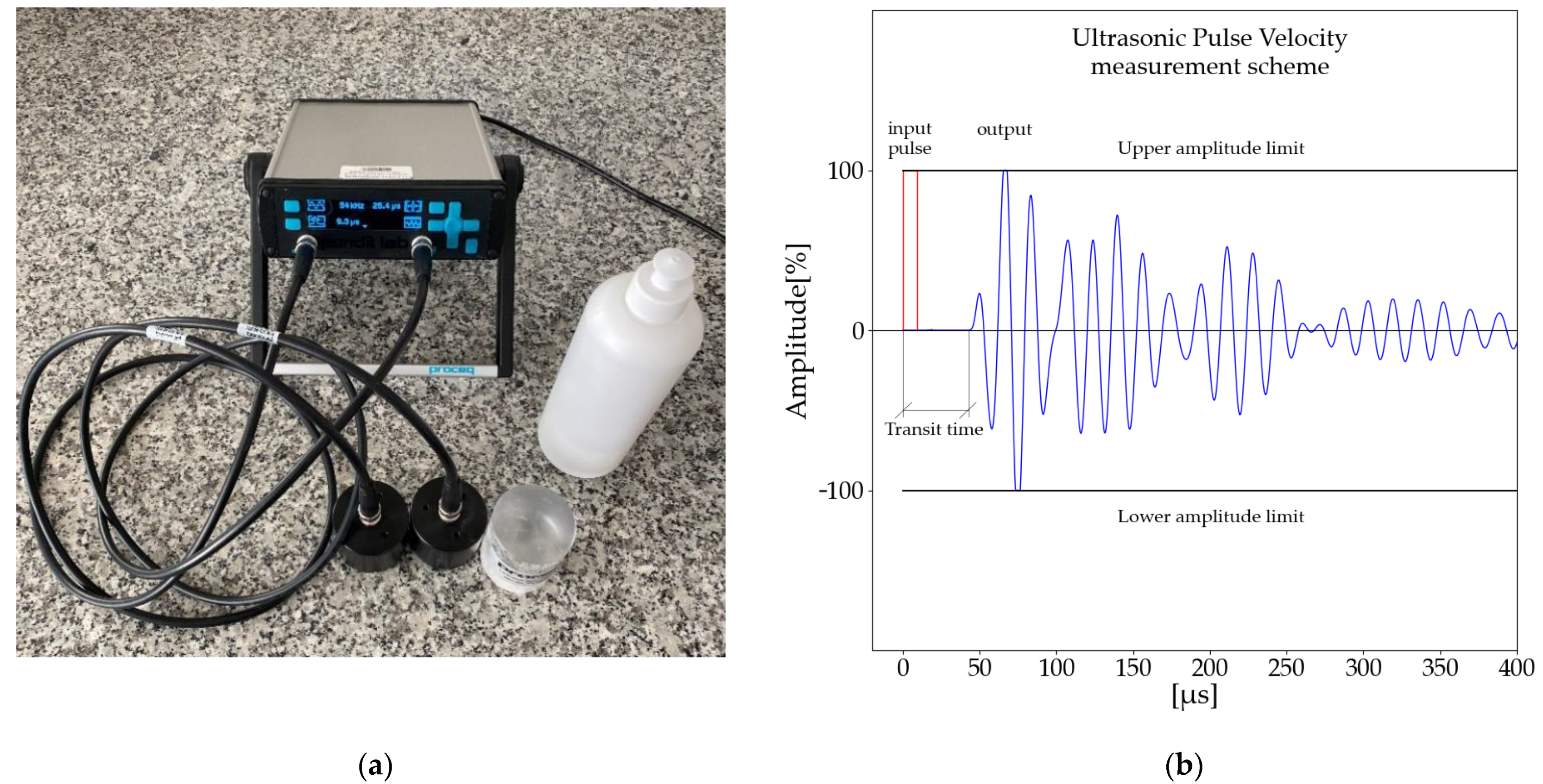

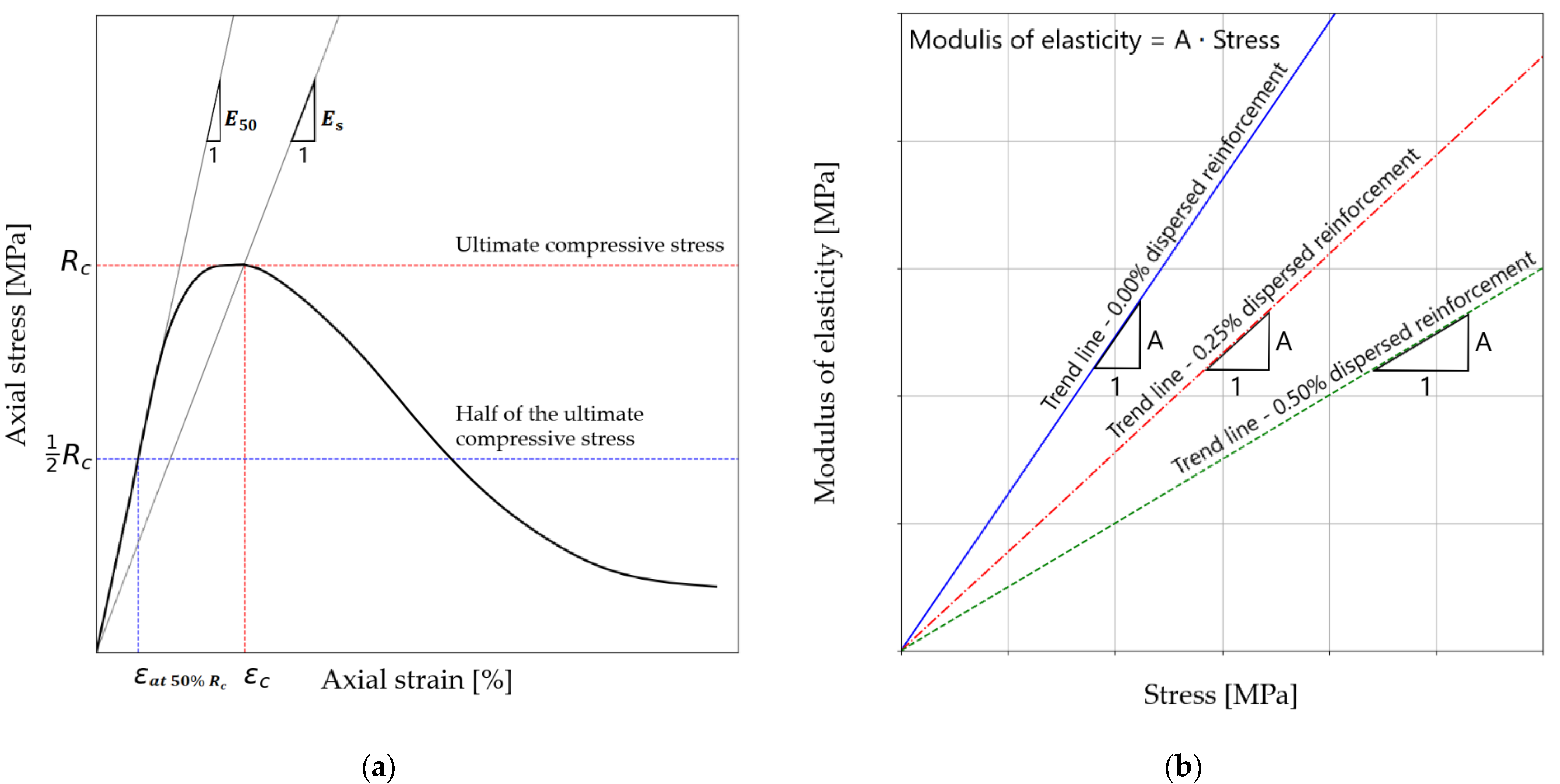

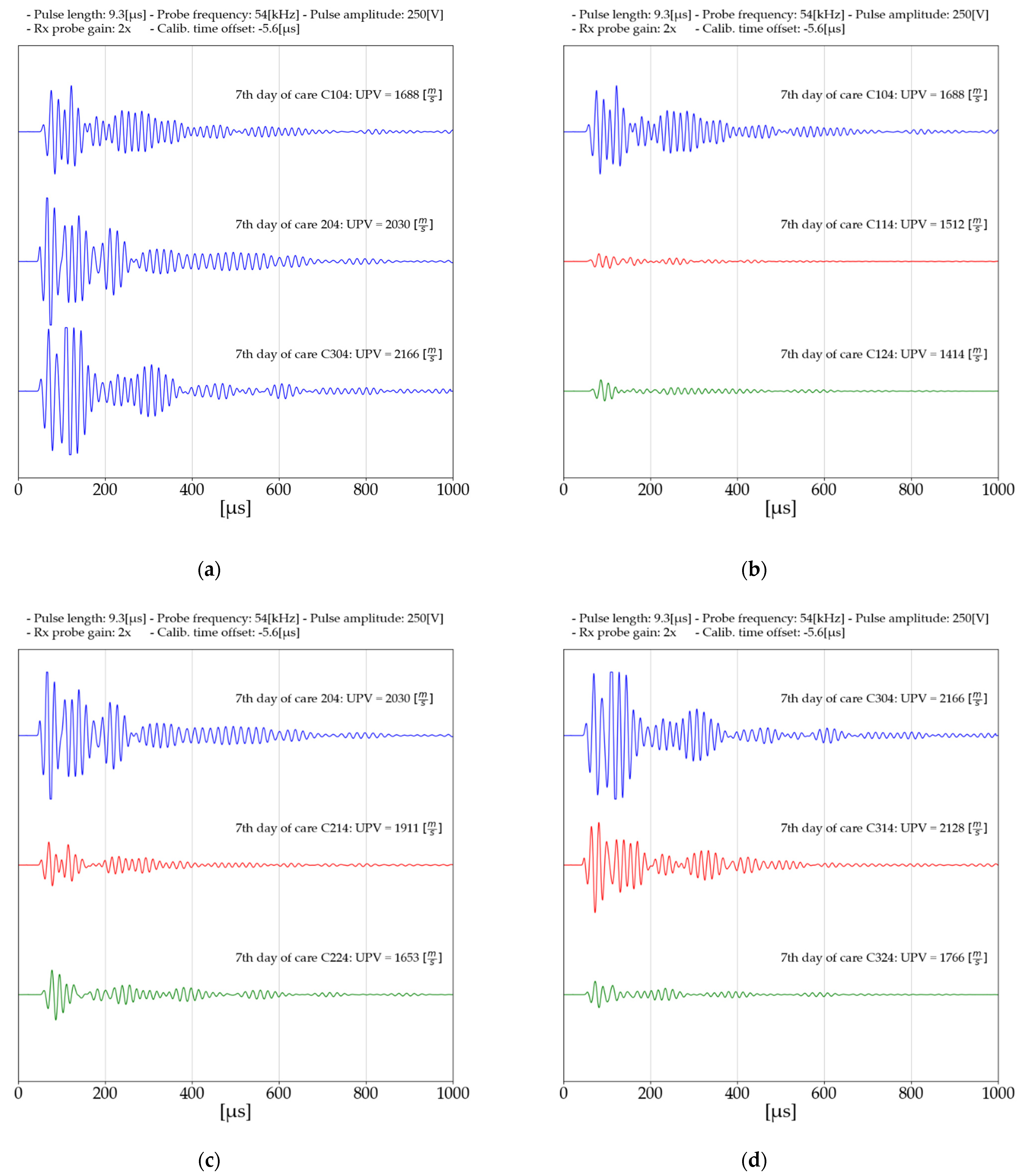
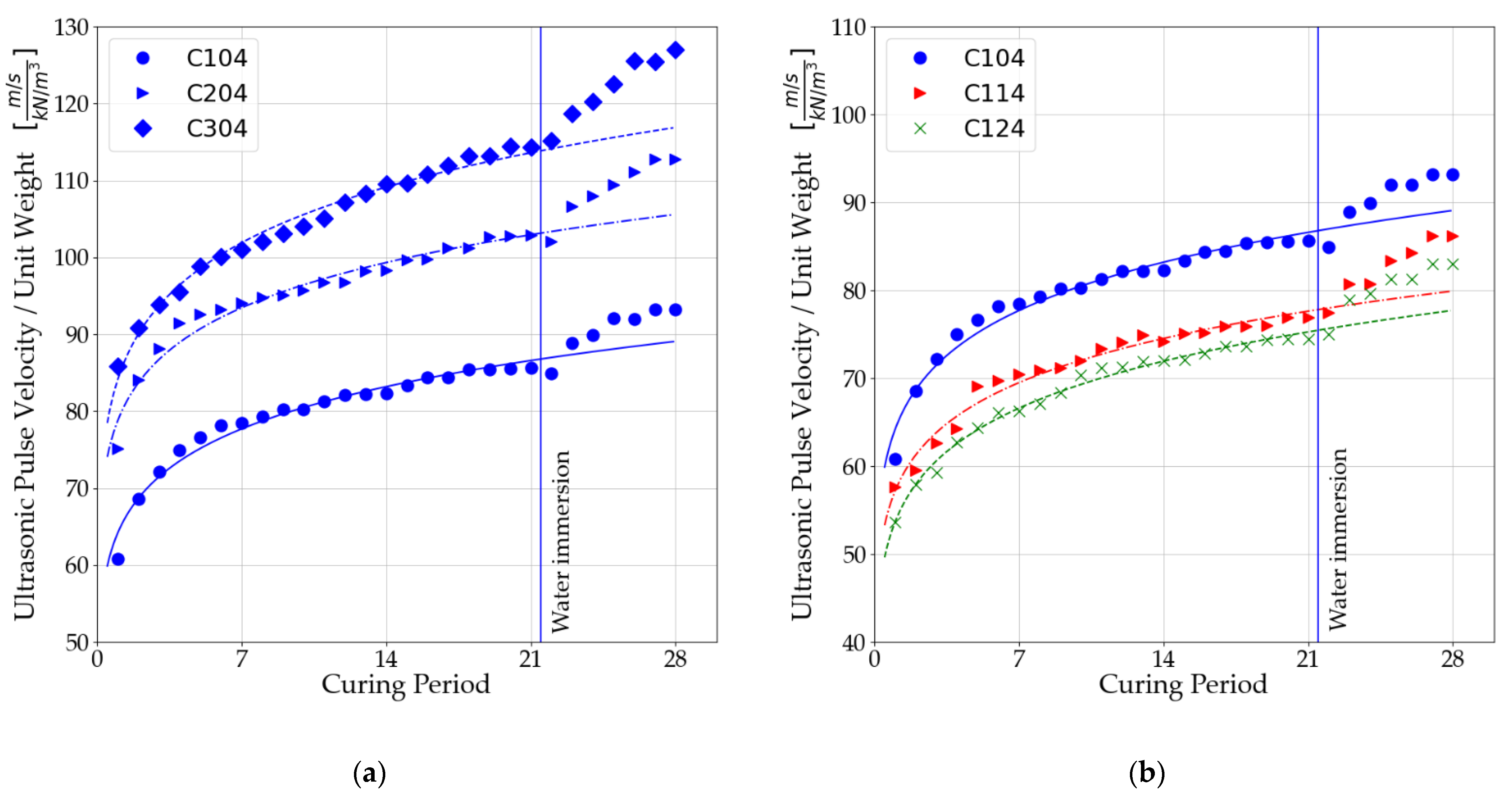
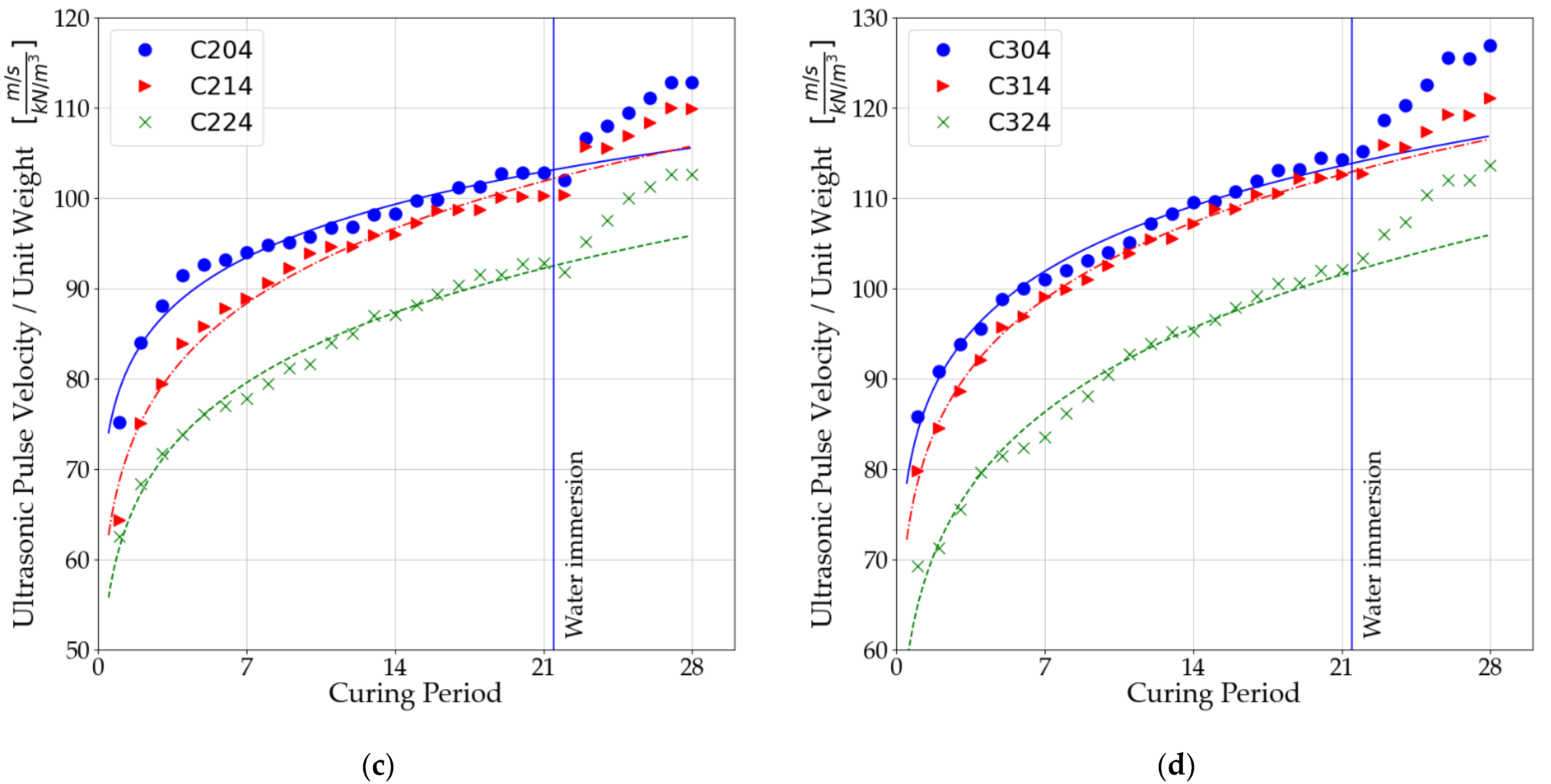
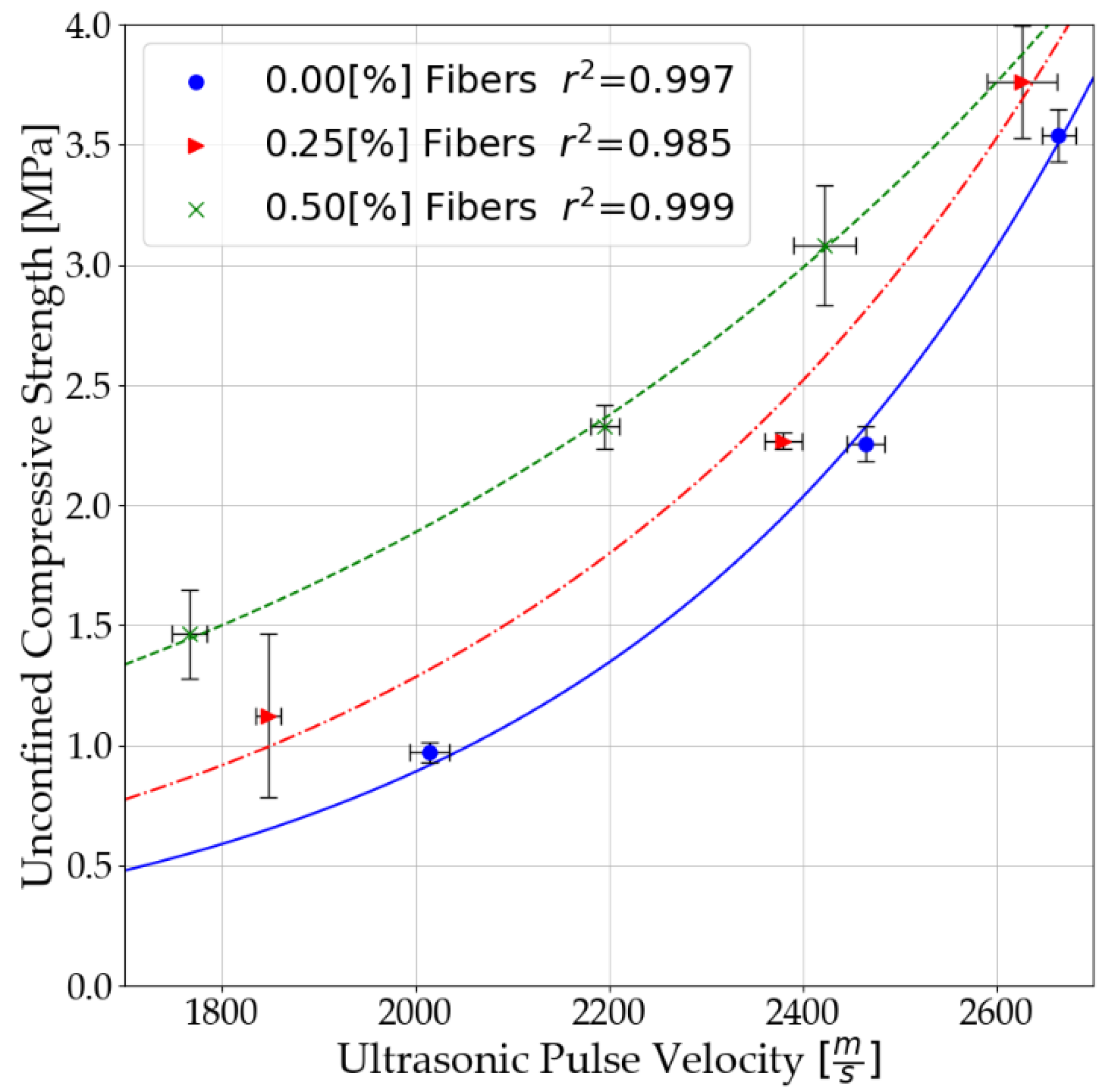

| Physical Properties of Soil | Value | Units |
|---|---|---|
| CC | 4.60 | [‒] |
| CU | 52 | [‒] |
| PI | 10.41 | [‒] |
| LI | 0.31 | [‒] |
| WL | 18 | [%] |
| Wp | 7.59 | [%] |
| W | 10.8 | [%] |
| pH | 8.95 | [‒] |
| MDD | 2.08 | [g·cm−3] |
| OMC | 8.64 | [%] |
| Cohesion | 7 | [kPa] |
| Internal friction angle | 34.5 | [°] |
| Properties of Binder | Value | Units |
|---|---|---|
| Required compressive strength after 7 days | ≥16.0 | [MPa] |
| Required compressive strength after 28 days | ≥32.5 | [MPa] |
| ≤52.5 | [MPa] | |
| Hydration heat | ≤270 | [J/g] |
| Properties of Fibers | Value | Units |
|---|---|---|
| Single fiber length | 12 | [mm] |
| Diameter of a single fiber | 32 | [µm] |
| Tensile strength | 300 ÷ 400 | [MPa] |
| Mixture Name | Binder [%] | Fibers [‰] | OMC [%] | MDD [g·cm−3] |
|---|---|---|---|---|
| C104 | 3 | 0 | 9.9 | 1.99 |
| C114 | 3 | 2.5 | 10.2 | 1.96 |
| C124 | 3 | 5 | 10.9 | 1.96 |
| C204 | 5 | 0 | 10.1 | 1.99 |
| C214 | 5 | 2.5 | 10.35 | 1.97 |
| C224 | 5 | 5 | 11.1 | 1.96 |
| C304 | 7 | 0 | 11.1 | 1.96 |
| C314 | 7 | 2.5 | 11.7 | 1.95 |
| C324 | 7 | 5 | 12.1 | 1.93 |
| Parameter | Value | Units |
|---|---|---|
| Range | 0.1–9999 | [µs] |
| Resolution | 0.1 | [µs] |
| Frequency | 24, 37, 54, 82, 150, 200, 220, 250, 500 | [kHz] |
| frequency used | 54 | [kHz] |
| Pulse width | 9.3 | [µs] |
| Excitation voltage | 125, 250, 350, 500 | [v] |
| Used Excitation voltage | 250 | [v] |
| Calib. Time offset | −5.6 | [µs] |
| Details | Value | Units |
|---|---|---|
| Model | 5982 | [‒] |
| Force Measurement Accuracy | ±0.5 | [%] |
| Displacement Measurement Accuracy | ±0.01 | [mm] |
| Mixture Name | Without Immersion in Water | With Immersion in Water | [%] |
|---|---|---|---|
| C104 | 89.075 | 93.189 | 104.62 |
| C114 | 79.908 | 86.194 | 107.87 |
| C124 | 77.716 | 83.002 | 106.80 |
| C204 | 105.572 | 112.782 | 106.83 |
| C214 | 105.757 | 109.939 | 103.95 |
| C224 | 95.866 | 102.601 | 107.03 |
| C304 | 116.872 | 126.954 | 108.63 |
| C314 | 116.533 | 121.098 | 103.92 |
| C324 | 105.942 | 113.641 | 107.27 |
| Mixture Name | Binder [%] | Fibers [‰] | [‒] | [‒] |
|---|---|---|---|---|
| C104 | 3 | 0 | ||
| C204 | 5 | 0 | 0.01429578 | 0.00206532 |
| C304 | 7 | 0 | ||
| C114 | 3 | 2.5 | ||
| C214 | 5 | 2.5 | 0.04414984 | 0.0016846 |
| C314 | 7 | 2.5 | ||
| C124 | 3 | 5.0 | ||
| C224 | 5 | 5.0 | 0.18927741 | 0.00114934 |
| C324 | 7 | 5.0 |
| Fibers Content of the Stabilized Soil [‰] | E (Type) [MPa] | A [‒] | r2 [‒] |
|---|---|---|---|
| 0.0 | 88.257 | 0.880 | |
| 0.0 | 324.785 | 0.875 | |
| 2.5 | 72.324 | 0.807 | |
| 2.5 | 272.177 | 0.809 | |
| 5.0 | 49.734 | 0.883 | |
| 5.0 | 200.018 | 0.710 |
Publisher’s Note: MDPI stays neutral with regard to jurisdictional claims in published maps and institutional affiliations. |
© 2021 by the authors. Licensee MDPI, Basel, Switzerland. This article is an open access article distributed under the terms and conditions of the Creative Commons Attribution (CC BY) license (https://creativecommons.org/licenses/by/4.0/).
Share and Cite
Miturski, M.; Sas, W.; Radzevičius, A.; Šadzevičius, R.; Skominas, R.; Stelmaszczyk, M.; Głuchowski, A. Effect of Dispersed Reinforcement on Ultrasonic Pulse Velocity in Stabilized Soil. Materials 2021, 14, 6951. https://doi.org/10.3390/ma14226951
Miturski M, Sas W, Radzevičius A, Šadzevičius R, Skominas R, Stelmaszczyk M, Głuchowski A. Effect of Dispersed Reinforcement on Ultrasonic Pulse Velocity in Stabilized Soil. Materials. 2021; 14(22):6951. https://doi.org/10.3390/ma14226951
Chicago/Turabian StyleMiturski, Maciej, Wojciech Sas, Algirdas Radzevičius, Raimondas Šadzevičius, Rytis Skominas, Mateusz Stelmaszczyk, and Andrzej Głuchowski. 2021. "Effect of Dispersed Reinforcement on Ultrasonic Pulse Velocity in Stabilized Soil" Materials 14, no. 22: 6951. https://doi.org/10.3390/ma14226951






